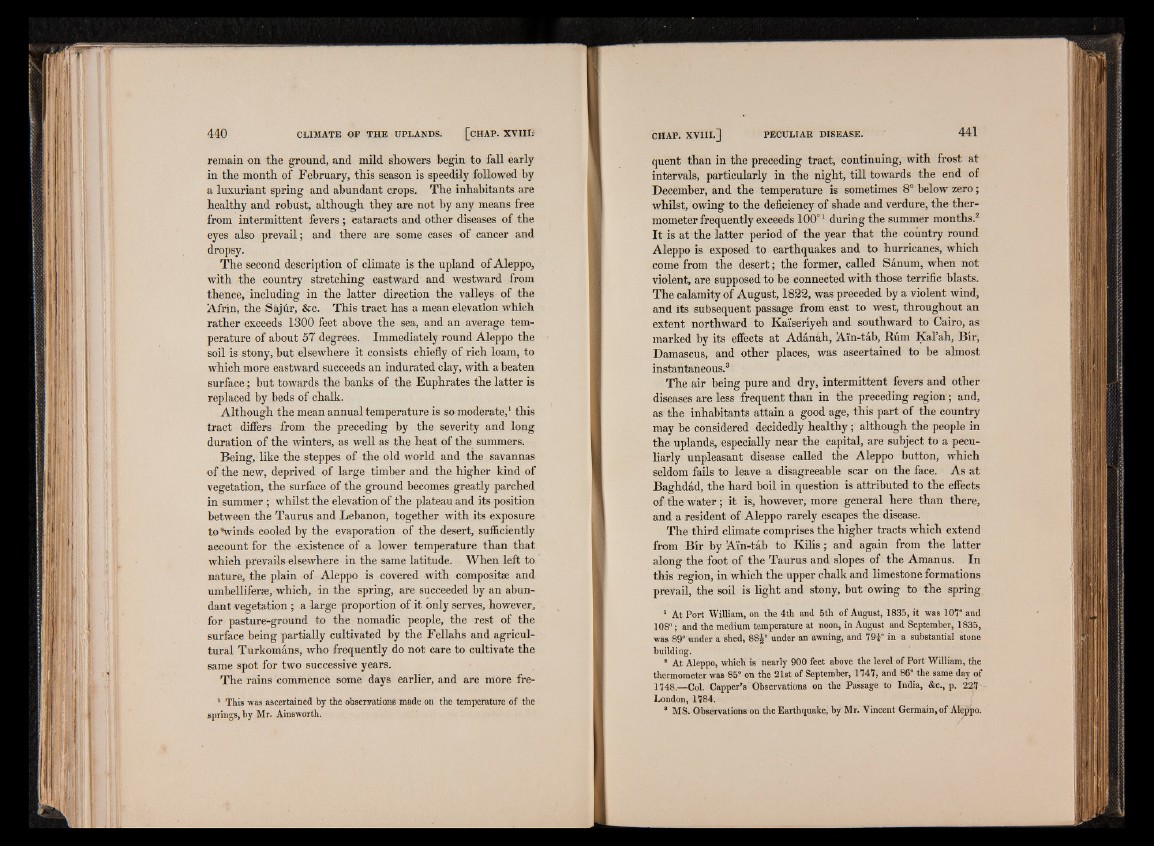
remain on tlie ground, and mild, showers begin to fall early
in the month of February, this season is speedily followed by
a luxuriant spring and abundant crops. The inhabitants are
healthy and robust, although they are not by any means free
from intermittent fevers ; cataracts and other diseases of the
eyes also prevail; and there are some cases of cancer and
dropsy.
The second description of climate is the upland of Aleppo,
with the country stretching eastward and westward from
thence, including in the latter direction the valleys of the
Afrin, the Sajur, &c. This tract has a mean elevation which
rather exceeds 1300 feet above the sea, and an average temperature
of about 57 degrees. Immediately round Aleppo the
soil is stony, but elsewhere it consists chiefly of rich loam, to
which more eastward succeeds an indurated clay, with a beaten
surface; but towards the banks of the Euphrates the latter is
replaced by beds of chalk.
Although the mean annual temperature is so moderate,1 this
tract differs from the preceding by the severity and long
duration of the winters, as well as the heat of the summers.
Being, like the steppes of the old world and the savannas
of the new, deprived of large timber and the higher kind of
vegetation, the surface of the ground becomes greatly parched
in summer; whilst the elevation of the plateau and its position
between the Taurus and Lebanon, together with its exposure
to *winds cooled by the evaporation of the desert, sufficiently
account for the -existence of a lower temperature than that
which prevails elsewhere in the same latitude. When left to
nature, the plain of Aleppo is covered with composite and
umbelliferse, which, in the spring, are succeeded by an abundant
vegetation ; a large proportion of it only serves, however,
for pasture-ground to the nomadic people, the rest of the
surface being partially cultivated by the Fellahs and agricultural
Turkomans, who frequently do not care to cultivate the
same spot for two successive years.
The rains commence some days earlier, and are more fre-
1 This was ascertained by the observations made on the temperature of the
springs, by Mr. Ainsworth.
quent than in the preceding tract, continuing, with frost at
intervals, particularly in the night, till towards the end of
December, and the temperature is sometimes 8° below zero;
whilst, owing to the deficiency of shade and verdure, the thermometer
frequently exceeds 100°1 during the summer months.2
It is at the latter period of the year that the country round
Aleppo is exposed to earthquakes and to hurricanes, which
come from the desert; the former, called Sanum, when not
violent, are supposed to be connected with those terrific blasts.
The calamity of August, 1822, was preceded by a violent wind,
and its subsequent passage from east to west, throughout an
extent northward to Kaiseriyeh and southward to Cairo, as
marked by its effects at Adanah, Ain-tab, Rum Kal’ah, Bir,
Damascus, and other places, was ascertained to be almost
instantaneous.3
The air being pure and dry, intermittent fevers and other
diseases are less frequent than in the preceding region; and,
as the inhabitants attain a good age, this part of the country
may be considered decidedly healthy; although the people in
the uplands, especially near the capital, are subject to a peculiarly
unpleasant disease called the Aleppo button, which
seldom fails to leave a disagreeable scar on the face. As at
Baghdad, the hard boil in question is attributed to the effects
of the water; it is, however, more general here than there,
and a resident of Aleppo rarely escapes the disease.
The third climate comprises the higher tracts which extend
from Bir by Ain-tab to K ilis; and again from the latter
along the foot of the Taurus and slopes of the Amanus. In
this region, in which the upper chalk and limestone formations
prevail, the soil is light and stony, but owing to the spring
1 At Port William, on the 4th and 5th of August, 1835, it was 107° and
108°; and the medium temperature at noon, in August and September, 1835,
was 89° under a shed, 88J° under an awning, and 79i° in a substantial stone
building.
! At Aleppo, which is nearly 900 feet above the level of Port William, the
thermometer was 85° on the 21st of September, 1747, and 86° the same day of
1748.—Col. Capper’s Observations on the Passage to India, &c., p. 22!p
London, 1784.
* MS. Observations on the Earthquake, by Mr. Vincent Germain, of Aleppo.